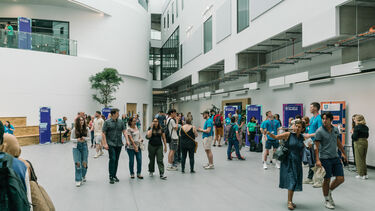Ethan studied BEng Aerospace Engineering and chose to do his undergraduate dissertation on the Classification of microstructural defects in selective laser melted inconel 713C alloy using convolutional neural networks. His project was supervised by Dr Meurig Thomas. Meurig is part of CMBE and teaches on the Aerospace Engineering degree - one of engineering’s interdisciplinary degree programmes.
Meurig said: “The MST Undergraduate Research article is a new initiative by the journal, which is designed to complement science and engineering education and to encourage undergraduates to pursue research careers so it is fantastic to see Ethan continue his research career in our School.”
Ethan started his PhD just after graduating in 2024. Since then he has been on training sessions with the Fusion Power CDT at several universities around the UK and working on his PhD Project, supervised by Professor Chris Race.
Ethan’s research focuses on the multi-scale modelling of materials in extreme environments, with a particular emphasis on the behaviour of dislocations in the presence of abundant point defects in crystalline materials. This work is crucial for understanding and improving the performance of materials used in nuclear fusion reactor components, where extreme conditions pose significant challenges to material integrity and longevity. Ethan said:
One of the most rewarding experiences during my career so far was publishing a journal article as an undergraduate student. My dissertation supervisor, Dr. Meurig Thomas, and I published an article relating to my dissertation in Materials Science and Technology, a journal hosted by the Institute of Materials, Mining and Minerals, earlier this year (accepted Dec 2024, posted Jan 2025). The article is titled ‘Classification of microstructural defects in selective laser melted Inconel 713C alloy using convolutional neural networks’.
The work focuses on the automated classification of microstructural defects, which are common in additively manufactured materials and can significantly impact their bulk properties. Building on the work of Aziz et al., we explored alternative methods to manual classification, which is labour-intensive and costly. In this study, we discuss methods for dataset creation, augmentation, and hyperparameter optimisation to improve classification performance.”


